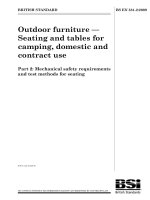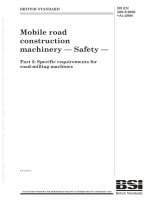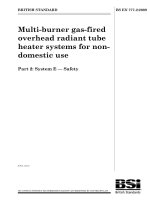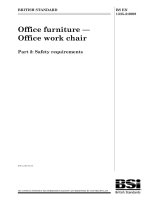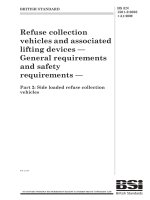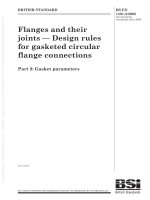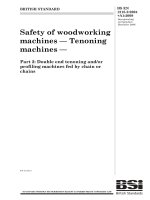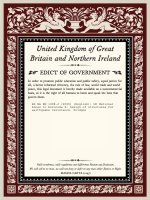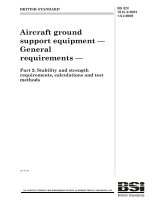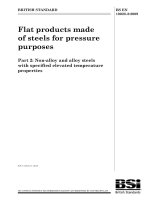Bsi bs en 62024 2 2009
Bạn đang xem bản rút gọn của tài liệu. Xem và tải ngay bản đầy đủ của tài liệu tại đây (860.84 KB, 22 trang )
BS EN 62024-2:2009
BSI British Standards
High frequency inductive
components — Electrical
characteristics and measuring
methods —
Part 2: Rated current of inductors for DC to DC
converters
NO COPYING WITHOUT BSI PERMISSION EXCEPT AS PERMITTED BY COPYRIGHT LAW
raising standards worldwide™
标准分享网 www.bzfxw.com 免费下载
BRITISH STANDARD
BS EN 62024-2:2009
National foreword
This British Standard is the UK implementation of EN 62024-2:2009. It is
identical to IEC 62024-2:2008.
The UK participation in its preparation was entrusted to Technical Committee
EPL/51, Transformers, inductors, magnetic components and ferrite materials.
A list of organizations represented on this committee can be obtained on
request to its secretary.
This publication does not purport to include all the necessary provisions of a
contract. Users are responsible for its correct application.
© BSI 2009
ISBN 978 0 580 57267 8
ICS 29.100.10
Compliance with a British Standard cannot confer immunity from
legal obligations.
This British Standard was published under the authority of the Standards
Policy and Strategy Committee on 31 March 2009
Amendments issued since publication
Amd. No.
Date
Text affected
EUROPEAN STANDARD
EN 62024-2
NORME EUROPÉENNE
January 2009
EUROPÄISCHE NORM
ICS 29.100.10
English version
High frequency inductive components Electrical characteristics and measuring methods Part 2: Rated current of inductors for DC to DC converters
(IEC 62024-2:2008)
Composants inductifs à haute fréquence Caractéristiques électriques
et méthodes de mesure Partie 2: Courant assigné
des bobines d’induction
des convertisseurs continus-continus
(CEI 62024-2:2008)
Induktive Hochfrequenz-Bauelemente Elektrische Eigenschaften
und Messmethoden Teil 2: Bemessungsstrom
von Drosselspulen für DC/DC-Wandler
(IEC 62024-2:2008)
This European Standard was approved by CENELEC on 2008-12-01. CENELEC members are bound to comply
with the CEN/CENELEC Internal Regulations which stipulate the conditions for giving this European Standard
the status of a national standard without any alteration.
Up-to-date lists and bibliographical references concerning such national standards may be obtained on
application to the Central Secretariat or to any CENELEC member.
This European Standard exists in three official versions (English, French, German). A version in any other
language made by translation under the responsibility of a CENELEC member into its own language and notified
to the Central Secretariat has the same status as the official versions.
CENELEC members are the national electrotechnical committees of Austria, Belgium, Bulgaria, Cyprus, the
Czech Republic, Denmark, Estonia, Finland, France, Germany, Greece, Hungary, Iceland, Ireland, Italy, Latvia,
Lithuania, Luxembourg, Malta, the Netherlands, Norway, Poland, Portugal, Romania, Slovakia, Slovenia, Spain,
Sweden, Switzerland and the United Kingdom.
CENELEC
European Committee for Electrotechnical Standardization
Comité Européen de Normalisation Electrotechnique
Europäisches Komitee für Elektrotechnische Normung
Central Secretariat: avenue Marnix 17, B - 1000 Brussels
© 2009 CENELEC -
All rights of exploitation in any form and by any means reserved worldwide for CENELEC members.
Ref. No. EN 62024-2:2009 E
标准分享网 www.bzfxw.com 免费下载
EN 62024-2:2009
-2-
Foreword
The text of document 51/937/FDIS, future edition 1 of IEC 62024-2, prepared by IEC TC 51, Magnetic
components and ferrite materials, was submitted to the IEC-CENELEC parallel vote and was approved by
CENELEC as EN 62024-2 on 2008-12-01.
The following dates were fixed:
– latest date by which the EN has to be implemented
at national level by publication of an identical
national standard or by endorsement
(dop)
2009-09-01
– latest date by which the national standards conflicting
with the EN have to be withdrawn
(dow)
2011-12-01
Annex ZA has been added by CENELEC.
__________
Endorsement notice
The text of the International Standard IEC 62024-2:2008 was approved by CENELEC as a European
Standard without any modification.
__________
-3-
EN 62024-2:2009
Annex ZA
(normative)
Normative references to international publications
with their corresponding European publications
The following referenced documents are indispensable for the application of this document. For dated
references, only the edition cited applies. For undated references, the latest edition of the referenced
document (including any amendments) applies.
NOTE When an international publication has been modified by common modifications, indicated by (mod), the relevant EN/HD
applies.
Publication
Year
IEC 60068-1
-
1)
IEC 62025-1
-
1)
1)
Undated reference.
2)
Valid edition at date of issue.
Title
EN/HD
Year
Environmental testing Part 1: General and guidance
EN 60068-1
1994
2)
High frequency inductive components EN 62025-1
Non-electrical characteristics and measuring
methods Part 1: Fixed, surface mounted inductors for
use in electronic and telecommunication
equipment
2007
2)
标准分享网 www.bzfxw.com 免费下载
BS EN 62024-2:2009
–2–
62024-2 © IEC:2008(E)
CONTENTS
FOREWORD...........................................................................................................................3
1
Scope ...............................................................................................................................5
2
Normative references .......................................................................................................5
3
Terms and definitions .......................................................................................................5
4
Standard atmospheric conditions ......................................................................................6
5
4.1 Standard atmospheric conditions for testing ............................................................6
4.2 Reference conditions...............................................................................................6
Measuring method of DC saturation limited current...........................................................6
6
5.1 General ...................................................................................................................6
5.2 Test conditions ........................................................................................................6
5.3 Measurement circuit and calculation ........................................................................7
5.4 Attachment jig of inductor ........................................................................................8
5.5 Measuring method ...................................................................................................8
5.6 Quality conformance inspection ...............................................................................8
Measuring method of temperature rise limited current ......................................................8
6.1
6.2
6.3
7
General ...................................................................................................................8
Test conditions ........................................................................................................9
Measurement jig ......................................................................................................9
6.3.1 Printed-wiring board method ........................................................................9
6.3.2 Lead wire method ...................................................................................... 11
6.4 Measuring method and calculation ........................................................................ 12
6.4.1 Resistance-substitution method ................................................................. 12
6.4.2 Thermo-couple method .............................................................................. 13
6.5 Quality conformance inspection ............................................................................. 14
Determination of rated current ........................................................................................ 14
8
Information to be given in the detail specification............................................................ 14
8.1 Measuring method of DC saturation limited current ............................................... 14
8.2 Measuring method of temperature rise limited current ........................................... 15
Annex A (informative) Example of recommended description on product specification
sheets and catalogues .......................................................................................................... 16
Figure 1 – Inductance measurement circuit under application of DC saturation
condition .................................................................................................................................7
Figure 2a) – Example of printed-wiring board for SMD type .................................................. 10
Figure 2b) – Example of printed-wiring board for leaded type................................................ 11
Figure 2 – Example of printed-wiring board ........................................................................... 11
Figure 3 – Temperature rise measurement circuit by resistance substitution method............. 12
Figure 4 – Temperature rise measurement circuit by thermo-couple method ......................... 13
Table 1 – Width of circuits ......................................................................................................9
Table 2 – Wire size of circuits ............................................................................................... 12
BS EN 62024-2:2009
62024-2 © IEC:2008(E)
–3–
INTERNATIONAL ELECTROTECHNICAL COMMISSION
____________
HIGH FREQUENCY INDUCTIVE COMPONENTS –
ELECTRICAL CHARACTERISTICS AND MEASURING METHODS –
Part 2: Rated current of inductors for DC to DC converters
FOREWORD
1) The International Electrotechnical Commission (IEC) is a worldwide organization for standardization comprising
all national electrotechnical committees (IEC National Committees). The object of the IEC is to promote
international co-operation on all questions concerning standardization in the electrical and electronic fields. To
this end and in addition to other activities, IEC publishes International Standards, Technical Specifications,
Technical Reports, Publicly Available Specifications (PAS) and Guides (hereafter referred to as “IEC
Publication(s)“). Their preparation is entrusted to technical committees; any IEC National Committee interested
in the subject dealt with may participate in this preparatory work. International, governmental and nongovernmental organizations liaising with the IEC also participate in this preparation. IEC collaborates closely
with the International Organization for Standardization (ISO) in accordance with conditions determined by
agreement between the two organizations.
2) The formal decisions or agreements of IEC on technical matters express, as nearly as possible, an international
consensus of opinion on the relevant subjects since each technical committee has representation from all
interested IEC National Committees.
3) IEC Publications have the form of recommendations for international use and are accepted by IEC National
Committees in that sense. While all reasonable efforts are made to ensure that the technical content of IEC
Publications is accurate, IEC cannot be held responsible for the way in which they are used or for any
misinterpretation by any end user.
4) In order to promote international uniformity, IEC National Committees undertake to apply IEC Publications
transparently to the maximum extent possible in their national and regional publications. Any divergence
between any IEC Publication and the corresponding national or regional publication shall be clearly indicated in
the latter.
5) IEC provides no marking procedure to indicate its approval and cannot be rendered responsible for any
equipment declared to be in conformity with an IEC Publication.
6) All users should ensure that they have the latest edition of this publication.
7) No liability shall attach to IEC or its directors, employees, servants or agents including individual experts and
members of its technical committees and IEC National Committees for any personal injury, property damage or
other damage of any nature whatsoever, whether direct or indirect, or for costs (including legal fees) and
expenses arising out of the publication, use of, or reliance upon, this IEC Publication or any other IEC
Publications.
8) Attention is drawn to the Normative references cited in this publication. Use of the referenced publications is
indispensable for the correct application of this publication.
9) Attention is drawn to the possibility that some of the elements of this IEC Publication may be the subject of
patent rights. IEC shall not be held responsible for identifying any or all such patent rights.
International Standard IEC 62024-2 has been prepared IEC technical committee 51: Magnetic
components and ferrite materials.
The text of this standard is based on the following documents:
FDIS
Report on voting
51/937/FDIS
51/941/RVD
Full information on the voting for the approval of this standard can be found in the report on
voting indicated in the above table.
This publication has been drafted in accordance with the ISO/IEC Directives, Part 2.
A list of all parts of IEC 62024 series, under the general title High frequency inductive
components – Electrical characteristics and measuring methods, can be found on the IEC
website.
标准分享网 www.bzfxw.com 免费下载
BS EN 62024-2:2009
–4–
62024-2 © IEC:2008(E)
The committee has decided that the contents of this publication will remain unchanged until
the maintenance result date indicated on the IEC web site under "" in
the data related to the specific publication. At this date, the publication will be
•
•
•
•
reconfirmed,
withdrawn,
replaced by a revised edition, or
amended.
A bilingual version of this publication may be issued at a later date.
BS EN 62024-2:2009
62024-2 © IEC:2008(E)
–5–
HIGH FREQUENCY INDUCTIVE COMPONENTS –
ELECTRICAL CHARACTERISTICS AND MEASURING METHODS –
Part 2: Rated current of inductors for DC to DC converters
1
Scope
This part of IEC 62024 specifies the measuring methods of the rated direct current limits for
small inductors.
Standardized measuring methods for the determination of ratings enable users to accurately
compare the current ratings given in various manufacturers’ data books.
This standard is applicable to leaded and surface mount inductors with dimensions according
to IEC 62025-1 and generally with rated current less than 22 A, although inductors with rated
current greater than 22 A are available that fall within the dimension restrictions of this
standard (no larger than 12 mm × 12 mm footprint approximately). These inductors are
typically used in DC to DC converters built on PCB, for electric and telecommunication
equipment, and small size switching power supply units.
The measuring methods are defined by the saturation and temperature rise limitations
induced solely by direct current.
2
Normative references
The following referenced documents are indispensable for the application of this document.
For dated references, only the edition cited applies. For undated references, the latest edition
of the referenced document (including any amendments) applies.
IEC 60068-1, Environmental testing – Part 1: General and guidance
IEC 62025-1, High frequency inductive components – Non-electrical characteristics and
measuring methods – Part 1: Fixed, surface mounted inductors for use in electronic and
telecommunication equipment
3
Terms and definitions
For the purposes of this document, the following terms and definitions apply.
3.1
DC saturation limited current
allowable value of DC current for which the decrease of the inductance is within the specified
value
3.2
temperature rise limited current
allowable value of DC current for which the self-generation heat of the inductor results in
temperature rise within the specified value
标准分享网 www.bzfxw.com 免费下载
BS EN 62024-2:2009
–6–
4
4.1
62024-2 © IEC:2008(E)
Standard atmospheric conditions
Standard atmospheric conditions for testing
Standard atmospheric conditions for testing shall be as follows (see 5.3.1 of IEC 60068-1):
–
temperature: 15 °C to 35 °C;
–
relative humidity: 25 % to 75 %;
–
air pressure: 86 kPa to 106 kPa.
In the event of dispute or where required, the measurements shall be repeated using the
referee temperatures and such other conditions as given in 4.2.
4.2
Reference conditions
For reference purposes, one of the standard atmospheric conditions for referee tests taken
from 5.2 of IEC 60068-1 shall be selected and shall be as follows:
–
temperature: 20 °C ± 2 °C;
–
relative humidity: 60 % to 70 %;
–
air pressure: 86 kPa to 106 kPa.
5
Measuring method of DC saturation limited current
5.1
General
When alternating current in which DC current is superimposed is supplied to an inductor, the
inductance of the inductor decreases according to the DC current value.
In a typical application, the saturation current results from the peak current of the
superposition of AC on DC current. In this standard, the saturation current is measured as DC
current offsetting a small signal AC current.
NOTE It is not practical to set a standard for AC saturation limited current, because there are an unlimited
number of different ways to apply AC current in an application. Therefore, manufacturers and users have generally
defined DC saturation limited current as a common point of reference. This standard does the same.
5.2
Test conditions
Unless otherwise specified in the detail specification, the test conditions shall be in
accordance with Clause 4.
NOTE The variation of the value of DC saturation limited current, as a function of temperature, is dependent on
the magnetic material and the structure of the magnetic core of the inductor. However, measurement of DC
saturating currents at elevated temperatures is generally not practical for inspection purposes. Therefore, the
measurement at room temperature as provided by this standard is generally applied for specification purposes. Derating curves indicating variation of DC saturation limited current as a function of maximum operating temperature
of the inductor can be generated. These curves can be used to correlate the DC saturation limited current at room
temperature to the DC saturation limited current at typical operating temperatures. In some cases, it will become
necessary for the manufacturer and user to agree on an additional specification at a high temperature such as
85 °C, 105 °C or 125 °C.
BS EN 62024-2:2009
62024-2 © IEC:2008(E)
5.3
a)
–7–
Measurement circuit and calculation
Measuring circuit
The measuring circuit is as shown in Figure 1.
DC superimposed current supply
Virtual ground
Rs
Specimen
C
C
OSC
C
Rr
Ir
C
V1
fs
Ix
–
E1
+
V2
E2
IEC 1726/08
Components
Rs
source resistor R = R s
Rr
range resistor R = R r
V1
voltmeter V 1 = E 1
V2
voltmeter V 2 = E 2
C
DC current blocking capacitor
Supplies
fs
frequency of source
Ir
supplied current to range resistor
Ix
supplied current to specimen
I x = Ir
Figure 1 – Inductance measurement circuit under
application of DC saturation condition
b)
Calculation
Voltages E 1 and E 2 shall be measured when frequency f s and voltage E s of the signal
generator are supplied in accordance with the detail specification, and an initial value of the
inductance shall be calculated by the following formulas.
Zx =
E1 − E1
=
Rr
Ir
E2
Z x = Z x cos θ + j Z x sin θ
Z x = Rx + jX x
Lx =
Xx
ω
=
Xx
2πf s
标准分享网 www.bzfxw.com 免费下载
BS EN 62024-2:2009
–8–
62024-2 © IEC:2008(E)
where
Rx
is the resistance of the specimen;
Xx
is the reactance of the specimen;
Zx
is the impedance of the specimen;
Lx
is the equivalent series inductance of the specimen;
E1
is applied voltage to specimen;
E2
θ
is applied voltage to range resistor (= I r R r ) (E 2 can be regarded as current);
is phase angle difference between E 1 and E 2 .
5.4
Attachment jig of inductor
Attachment jig of specimen shall be specified in the detail specification.
5.5
Measuring method
a) Short compensation shall be done before measurement.
b) The specimen shall be connected to the circuit shown in Figure 1, by using the attachment
jig specified in 5.4.
c) When the specimen is connected by soldering, it shall be left until it becomes cool enough.
d) Voltages E 1 and E 2 shall be measured when frequency f s and voltage E s of the signal
generator are supplied in accordance with the detail specification, and an initial value of
the inductance shall be calculated by the formulas of 5.3 b).
e) The value of the DC current that is superimposed on the specimen shall be modulated and
the inductance value shall be measured.
f)
The decrease from the initial value of the inductance shall be calculated. DC saturation
limited current shall be determined by measuring the DC current when the decrease in
inductance matches the specified value in the detail specification.
g) The decrease in inductance that is specified in the detail specification should be 10 % or
30 %.
NOTE 10 % is one of the design points typical for sharp-saturating inductors, and 30 % is one of the design points
typical for soft-saturating inductors. See Annex A.
5.6
Quality conformance inspection
The DC current specified in the detail specification shall be supplied to a specimen in
accordance with the methods specified in 5.3 to 5.5, and then inductance shall be measured.
The decrease in inductance shall be within the specified value.
6
6.1
Measuring method of temperature rise limited current
General
When DC current is supplied to an inductor, the inductor generates heat by itself according to
the supplied DC current value because of its DC current resistance.
NOTE 1 Temperature rise results from self-heating of the inductor. The sources of heating are DC copper losses,
AC copper losses and AC core losses. This standard defines the temperature rise induced only by DC currents. In
specific applications, it is necessary to consider AC copper losses and AC core losses for the temperature rise. AC
losses are highly affected by waveform, amplitude and frequency.
NOTE 2 It is not practical to set a standard for AC temperature rise limited current, because there are an
unlimited number of different ways to apply AC current in an application. In DC to DC converters, often AC loss is
far smaller than DC loss. Therefore, manufacturers and users have generally defined DC temperature rise limited
current as a common point of reference. This standard does the same.
BS EN 62024-2:2009
62024-2 © IEC:2008(E)
6.2
–9–
Test conditions
Unless otherwise specified in the detail specification, the test conditions shall be in
accordance with Clause 4.
Since the value of DC current resistance increases as a function of temperature, some
applications require a high ambient temperature such as 85 °C, 105 °C or 125 °C for the
temperature rise test.
NOTE 1 The overall power loss of an inductor is a combination of DC power loss due to DC current resistance, as
well as AC power loss due to AC current in the windings and losses due to the corresponding AC flux induced in
the magnetic core. The value of AC and DC current resistance (the conductor resistance) increases with
temperature, thus the power loss associated with conductor resistance increases with temperature. The loss
associated with the magnetic core is all due to AC excitation. The core loss decreases with increasing temperature
up to a temperature typically referred to as the core loss minima temperature, above which point this loss begins to
increase. The minima temperature and magnitude of loss is dependent on the magnetic material type and grade.
Most ferrites exhibit sharp minima temperatures, while powder alloys do not. These considerations must be taken
into account when applying temperature rise currents to applications with high operating temperatures and a nontrivial amount of AC power loss in addition to DC power loss. The overall total loss at any given temperature may
be dominated by DC loss or AC loss dependent on the power loss distribution at room temperature as well as the
variation of each of these power losses with temperature.
NOTE 2 Regarding DC temperature rise limited currents at high temperatures, the variation in DC temperature
rise limited current with ambient temperature variation can be predicted. Moreover, measurement of DC
temperature rise limited currents at elevated temperatures is generally not practical. Therefore, the measurement
at room temperature as provided by this standard is generally applied.
6.3
Measurement jig
The measurement jig shall be either printed-wiring board method given in 6.3.1 or lead wire
method given in 6.3.2, and shall be specified in the detail specification.
6.3.1
Printed-wiring board method
Printed-wiring board shall be made of epoxide woven glass (FR4). Unless otherwise specified
in the detail specification, the dimensions shall be as shown in Table 1 and Figure 2.
Table 1 – Width of circuits
a
Rated current of inductor
I
Pattern width a
W
A
mm
I≤1
1,0 ± 0,2
1< I ≤ 2
2,0 ± 0,2
2
3,0 ± 0,3
3
5,0 ± 0,3
5
7,0 ± 0,5
7 < I ≤ 11
11,0 ± 0,5
11 < I ≤ 16
16,0 ± 0,5
16 < I ≤ 22
22,0 ± 0,5
22 < I
According to the detail specification
See Figure 2.
标准分享网 www.bzfxw.com 免费下载
BS EN 62024-2:2009
62024-2 © IEC:2008(E)
– 10 –
Dimension in millimetres
100,0 ± 1,0
10,0 ± 0,5
2,0 ± 0,1
40,0 ± 1,0
20,0 ± 0,5
5,0 ± 0,5
80,0 ± 1,0
0,035 ± 0,010
2,0 ± 0,1
1,0 ± 0,1
2,0 ± 0,1
30,0 ± 0,5
b
a
c
W
0,2 ± 0,1
0,2 ± 0,1
IEC 1727/08
Figure 2a) – Example of printed-wiring board for SMD type
BS EN 62024-2:2009
62024-2 © IEC:2008(E)
– 11 –
Dimension in millimetres
100,0 ± 1,0
10,0 ± 0,5
2,0 ± 0,1
40,0 ± 1,0
20,0 ± 0,5
5,0 ± 0,5
80,0 ± 1,0
0,035 ± 0,010
2,0 ± 0,1
1,0 ± 0,1
2,0 ± 0,1
30,0 ± 0,5
p
d1 d2
W
0,2 ± 0,1
0,2 ± 0,1
IEC 1728/08
Figure 2b) – Example of printed-wiring board for leaded type
Key
solderable areas
non-solderable areas (covered with non-solderable lacquer)
NOTE 1
a, b, c, d 1 , d 2 and p: according to the detail specification.
NOTE 2
Materials of substrate: epoxide woven glass (FR4).
NOTE 3
Materials of pattern: copper.
NOTE 4
Thickness of pattern: 0,035 mm ± 0,010 mm.
NOTE 5
Pattern width (W): see Table 1.
Figure 2 – Example of printed-wiring board
6.3.2
Lead wire method
Unless otherwise specified in the detail specification, the wire diameter of lead wire to
connect the inductor and the measurement circuit shall be in accordance with Table 2.
标准分享网 www.bzfxw.com 免费下载
BS EN 62024-2:2009
62024-2 © IEC:2008(E)
– 12 –
Table 2 – Wire size of circuits
Rated current of inductors
I
A
Wire size
mm
AWG (for reference)
I≤3
0,50 ± 0,05
24
3
0,65 ± 0,05
22
5 < I ≤ 11
0,8 ± 0,1
20
11 < I ≤ 16
1,0 ± 0,1
18
16 < I ≤ 22
1,3 ± 0,1
16
According to the detail specification
22 < I
6.4
NOTE 1
The wire size refers to MIL standard (MIL-PRF-15733).
NOTE 2
AWG is a wire diameter number of American Wire Gauge.
Measuring method and calculation
Measuring method shall be either the resistance substitution method of 6.4.1 or the thermocouple method of 6.4.2, and shall be specified in the detail specification.
6.4.1
Resistance-substitution method
a) The specimen shall be connected to the circuit shown in Figure 3, by using the
measurement jig specified in 6.3.
Voltmeter
Ex
V
Rx
Specimen
Ammeter
A
Ix
DC power supply
IEC 1729/08
Figure 3 – Temperature rise measurement circuit by resistance substitution method
b) When the specimen is connected by soldering, it shall be left until it becomes cool enough.
c) The specimen should be measured inside a cubic box of roughly 20 cm on each side to
prevent temperature change from air flow. The box may have some vents in the top to
prevent trapping heat inside.
The specimen shall be measured on the condition that it does not contact directly to the
test board. When it is measured by mounting on the printed-wiring board, the printedcircuit board on which the specimen is mounted shall not contact directly to the test board.
d) The resistance value of the specimen and ambient temperature t a1 shall be measured
before DC current is supplied.
e) DC current shall be supplied to the specimen from a direct power supply. After the DC
voltage value of the specimen becomes steady, DC current value I x and DC voltage value
E x shall be measured by the ammeter and the voltmeter, and also ambient temperature t a2
shall be measured. Then the resistance value R x shall be calculated by the following
formula.
BS EN 62024-2:2009
62024-2 © IEC:2008(E)
– 13 –
Rx =
Ex
Ix
where
f)
Ix
is the DC current value;
Ex
is the DC voltage;
Rx
is the resistance of the specimen.
The temperature rise value t of the specimen shall be calculated by the following formula,
by using the resistivity coefficient of the metal and the resistance of the specimen.⏐t a1 –
t a2 ⏐ shall be 5 °C or less.
⎛ R − R1 ⎞
⎟⎟(C + ta1 ) + ta1 − ta2
t = t2 − ta2 = ⎜⎜ 2
⎝ R1 ⎠
where
t
is the temperature rise value (°C);
t2
is the temperature of the specimen when DC current is supplied (°C);
t a1
is the initial ambient temperature (°C);
t a2
is the ambient temperature when DC current is supplied (°C);
R1
is the resistance of winding at temperature t 1 = t a1 (Ω);
R2
is the resistance of winding at temperature t 2 (Ω);
is a material constant. C for copper = 234,5.
C
g) The value of the supplied DC current shall be modulated and the temperature rise value
shall be measured.
h) Temperature rise limited current shall be determined by measuring DC current when the
temperature rise value becomes the specified value in the detail specification.
i)
The temperature rise value that is specified in the detail specification should be 20 °C or
40 °C.
6.4.2
Thermo-couple method
a) The specimen shall be connected to the circuit shown in Figure 4, by using the
measurement jig specified in 6.3.
Thermo-couple
Specimen
Ammeter
A
DC power supply
IEC 1730/08
Figure 4 – Temperature rise measurement circuit by thermo-couple method
b) When the specimen is connected by soldering, it shall be left until it becomes cool enough.
c) The specimen should be measured inside a cubic box of roughly 20 cm on each side to
prevent temperature change from air flow. The box may have some vents in the top to
prevent trapping heat inside.
标准分享网 www.bzfxw.com 免费下载
BS EN 62024-2:2009
– 14 –
62024-2 © IEC:2008(E)
The specimen shall be measured on the condition that it does not contact directly to the
test board. When it is measured by mounting on the printed-wiring board, the printedwiring board on which the specimen is mounted shall not contact directly to the test board.
d) Consideration shall be given to the correct measurement position of the thermo-couple for
the temperature measurement. It should be placed at the location where the maximum
temperature of the inductor will occur. The best location may be direct contact at the
surface of the specimen, or within the coil by placing the thermo-couple inside, or under
the coil by positioning it prior to winding.
The measurement position shall be specified in the detail specification.
e) Temperature of the specimen t 1 and ambient temperature t a1 shall be measured before DC
current is supplied.
f)
DC current shall be supplied to the specimen from a DC power supply. After the
temperature of the specimen becomes steady, temperature of the specimen t 2 and
ambient temperature t a2 shall be measured again.
g) The value of the supplied DC current shall be modulated and the temperature rise value
shall be calculated by the following formula.
t = (t2 − ta2 ) − (t1 − ta1 )
where
t
is the temperature rise value (°C);
t1
is the initial temperature of the specimen (°C);
t2
is the temperature of the specimen when DC current is supplied (°C);
t a1
is the initial ambient temperature (°C);
t a2
is the ambient temperature when DC current is supplied (°C).
h) Temperature rise limited current shall be determined by measuring DC current when the
temperature rise value becomes the specified value in the detail specification.
i)
6.5
The temperature rise value that is specified in the detail specification should be 20 °C or
40 °C.
Quality conformance inspection
The DC current specified in the detail specification shall be supplied to a specimen in
accordance with the methods specified in 6.3 to 6.4, and then the temperature rise value shall
be measured.
The temperature rise value of the specimen shall be within the specified value.
7
Determination of rated current
For any inductor that is given a current rating, a DC saturation limited current value or a
temperature rise limited current value, whichever is less, defined and measured as shown in
this standard, shall be adopted as the rated current.
8
Information to be given in the detail specification
The following information shall be given in the detail specification.
8.1
Measuring method of DC saturation limited current
a) Frequency f s and voltage E s (see 5.3 b), 5.5 d)).
b) Attachment jig (see 5.4).
c) The allowable decrease in inductance (see 5.5 f).)
BS EN 62024-2:2009
62024-2 © IEC:2008(E)
– 15 –
d) DC saturation limited current (see 5.6).
8.2
Measuring method of temperature rise limited current
a) Measurement jig (see 6.3).
b) Measuring method (see 6.4).
c) Temperature rise value (see 6.4.1 h), 6.4.2 h)).
d) Measurement position (if thermo-couple method applied) (see 6.4.2 d)).
e) Temperature rise limited current (see 6.5).
标准分享网 www.bzfxw.com 免费下载
BS EN 62024-2:2009
– 16 –
62024-2 © IEC:2008(E)
Annex A
(informative)
Example of recommended description on product
specification sheets and catalogues
Both the DC saturation limited current value and the temperature rise limited current value
should be described on product specification sheets and catalogues.
It should be specified whether the DC saturation limited current value is determined when the
allowable decrease in inductance value is at 10 % or 30 %.
Sharp saturation is defined as inductance that decreases by more than 8 % for a 10 %
increase in bias current, measured where bias current has already reduced the inductance by
30 % compared with the unbiased inductance. Soft saturation is defined as inductance that
decreases by less than 8 % for a 10 % increase in bias current, measured where bias current
has already reduced the inductance by 30 % compared with the unbiased inductance.
Sharp saturating inductors have a steep drop in inductance beyond an inflection point, and
therefore they are specified and designed to operate at load currents that are less than the
current at the inflection point. 10 % is used for a standard specification point because it is a
typical design point. Other values, such as 20 % or 30 %, may be used by mutual agreement
between manufacture and user.
Soft saturating inductors have a continual and gradual drop in inductance, without a welldefined inflection point, and therefore they are specified and designed to operate at load
currents that typically push inductance down by 20 % to 50 %, or even more as the
application allows. 30 % is used for a standard specification point because it is a typical
design point (but not necessarily a requisite design point). Other values, such as 20 % or
50 %, may be used by mutual agreement between manufacture and user.
It should be specified whether the temperature rise limited current value is determined when
the temperature rise of the inductor is at 20 °C or 40 °C.
When the definition called a rated current is used, it should be the lower one of the DC
saturation limited current value and the temperature rise limited current value.
NOTE Unless otherwise specified in the detail specification, operating temperature is ambient temperature plus
temperature rise of inductors.
___________
